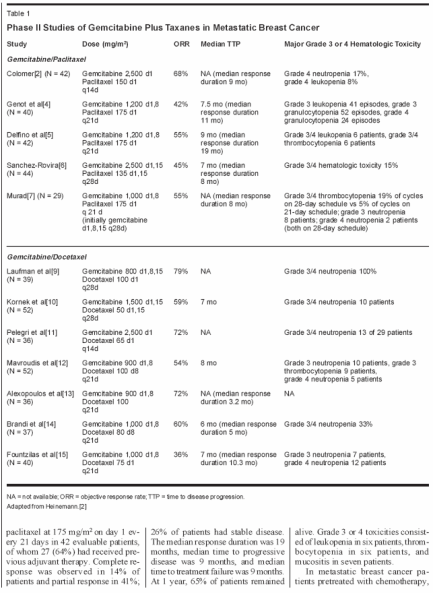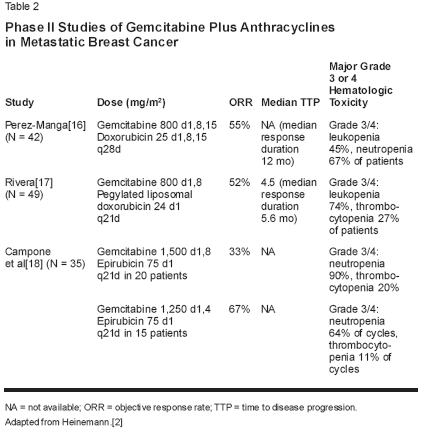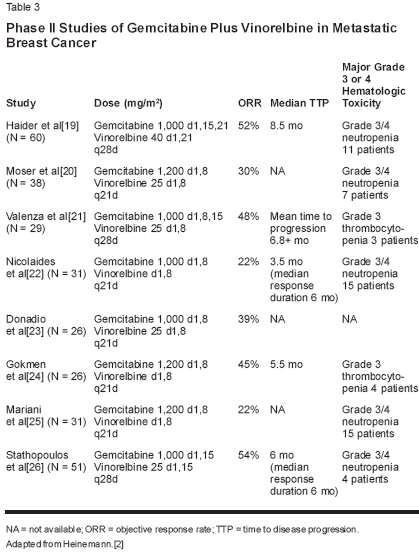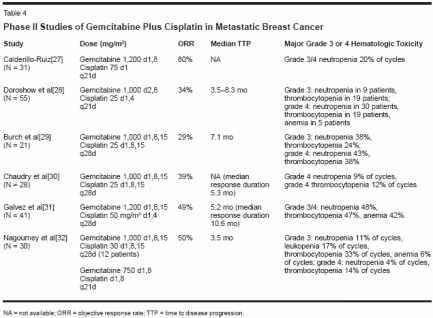Gemcitabine Combination Chemotherapy in Metastatic Breast Cancer: Phase II Experience
Gemcitabine has been evaluated in combination with paclitaxel,docetaxel, anthracyclines, vinorelbine, and cisplatin as first-line treatmentand after prior chemotherapy in patients with metastatic breastcancer. Results with gemcitabine/taxane combinations have been especiallyencouraging, with these combinations providing promising outcomeswith regard both to tumor response and tolerability. The combinationof gemcitabine and paclitaxel has garnered particular interestfor further phase III evaluation on the basis of high response rates anddurable responses in both treatment-naive and treatment-experiencedpatients, including anthracycline-pretreated patients.
ABSTRACT: Gemcitabine has been evaluated in combination with paclitaxel,docetaxel, anthracyclines, vinorelbine, and cisplatin as first-line treatmentand after prior chemotherapy in patients with metastatic breastcancer. Results with gemcitabine/taxane combinations have been especiallyencouraging, with these combinations providing promising outcomeswith regard both to tumor response and tolerability. The combinationof gemcitabine and paclitaxel has garnered particular interestfor further phase III evaluation on the basis of high response rates anddurable responses in both treatment-naive and treatment-experiencedpatients, including anthracycline-pretreated patients.Gemcitabine (Gemzar) is anucleoside antimetabolite thatundergoes intracellular phosphorylationto its activated diphosphateand triphosphate forms. Thetriphosphate form, which is competitivewith deoxycytidine-triphosphate,is incorporated into DNA, resulting inmasked DNA chain termination; thediphosphate form reduces deoxycytidinetriphosphate levels, resulting inincreased incorporation of gemcitabinetriphosphate. Gemcitabine exhibitssingle-agent activity in metastaticbreast cancer, including in heavily pretreatedpatients.[1,2] The agent hasbeen evaluated in patients with advancedbreast cancer in a variety oftwo-drug chemotherapy combinations.[2] Among these, the combinationof gemcitabine and paclitaxel ordocetaxel (Taxotere) has generatedconsiderable interest for evaluation inphase III trials.Gemcitabine/PaclitaxelFive phase II trials have examinedthe gemcitabine/paclitaxel combinationin advanced breast cancer (Table1).[2-8] Among trials evaluating thecombination as first-line treatment, Colomer and colleagues reported useof gemcitabine at 2,500 mg/m2 on day1 and paclitaxel at 150 mg/m2 on day1 every 14 days in 42 patients, ofwhom 72% had received adjuvanttherapy.[3] Complete response wasobserved in 10 patients (24%) andpartial response was observed in 19(45%). Median response duration was9 months. Grade 4 neutropenia occurredin 17% of patients and grade 4leukopenia occurred in 8%. One patientdeveloped neutropenic fever.Grade 3 thrombocytopenia, nausea/vomiting, neurosensory toxicity, andconstipation were each observed in4% of patients. Grade 3 elevation ofaspartate aminotransferase level wasobserved in 8% of patients.Genot et al assessed gemcitabineat 1,200 mg/m2 on days 1 and 8 andpaclitaxel at 175 mg/m2 on day 1 every21 days in patients who had receivedno previous chemotherapy formetastatic disease.[4] Among 36 evaluablepatients, two (6%) had a completeresponse and 13 (36%) had apartial response; seven (19%) had stabledisease. At the time of reporting,the median follow up was 175 days.Median response duration was 11.5months and median time to diseaseprogression was 7.5 months. The mostfrequent grade 3 hematologic toxicitieswere leukopenia (41 episodes) andgranulocytopenia (52 episodes); 24episodes of grade 4 granulocytopeniawere observed.Delfino et al assessed gemcitabineat 1,200 mg/m2 on days 1 and 8 and

paclitaxel at 175 mg/m2 on day 1 every21 days in 42 evaluable patients,of whom 27 (64%) had received previousadjuvant therapy. Complete responsewas observed in 14% ofpatients and partial response in 41%;26% of patients had stable disease.The median response duration was 19months, median time to progressivedisease was 9 months, and mediantime to treatment failure was 9 months.At 1 year, 65% of patients remainedalive. Grade 3 or 4 toxicities consistedof leukopenia in six patients, thrombocytopeniain six patients, andmucositis in seven patients.In metastatic breast cancer patientspretreated with chemotherapy, Sanchez-Rovira et al reported findingsin 44 heavily pretreated patients,of whom nearly all had previouslyreceived anthracyclines and 20% hadreceived paclitaxel.[6] Patients receivedgemcitabine at 2,500 mg/m2on days 1 and 15 and paclitaxel at 135mg/m2 on days 1 and 15 every 28days. Seven patients (16%) had a completeresponse and 13 (30%) had apartial response. The median responseduration was 8 months (range: 4 to 26months) and median survival was 12months (range: 4 to 28 months). Grade3 or 4 hematologic toxicity occurredin 15% of patients; 34% of patientsrequired granulocyte colony-stimulatingfactor (G-CSF) support.In a trial reported by Murad et al,patients previously treated with ananthracycline-containing regimenwere treated initially with gemcitabineat 1,000 mg/m2 on days 1, 8, and15 and paclitaxel at 175 mg/m2 onday 1 every 28 days.[7] After unacceptablethrombocytopenia occurredin the first five patients treated, dosingwas changed to a 21-day schedulewith gemcitabine given on days 1and 8 and paclitaxel on day 1. Five of29 (17%) evaluable patients had acomplete response and 11 (38%) hada partial response; six patients (21%)had stable disease. Median responseduration was 8 months (range: 4 to26 months) and median survival was12 months (range: 4 to 28+ months),with 1- and 2-year survival rates of45% and 30%, respectively. Grade 3or 4 thrombocytopenia was observedin five (19%) of 27 cycles using the28-day schedule compared with six(5%) of 110 cycles using the 21-dayschedule (P = 0.04). Eight patientshad grade 3 neutropenia; two hadgrade 4 neutropenia associated withfever, both during the 28-day treatmentcycle. Two patients had grade 3neuropathy.These findings suggest that gemcitabine/paclitaxel is effective as firstlinetreatment and in pretreatedpatients, with high responses rates anddurable responses being observed. Itis particularly encouraging that a highresponse rate was observed in anthracycline-pretreated patients, sincelow response rates have been reportedwith paclitaxel alone after anthracyclineanthracyclinefailure. The gemcitabine/paclitaxelcombination currently is beinginvestigated as first-line therapyin metastatic breast cancer patientswho have received prior anthracycline-based adjuvant therapy in a largephase III study.[8]Gemcitabine/DocetaxelLaufman and colleagues evaluatedgemcitabine at 800 mg/m2 on days1, 8, and 15 plus docetaxel at 100mg/m2 on day 1 every 4 weeks asfirst-line treatment in 39 evaluablemetastatic breast cancer patients, ofwhom the majority had received adjuvantanthracycline treatment (Table1).[2,9] Objective responses wereobserved in 79% of patients. Granulocytecolony-stimulating factor wasnot used prophylactically, and grade3 or 4 neutropenia occurred in allpatients.In a study by Kornek et al, 52 patients(43 chemotherapy-naive) receivedgemcitabine at 1,500 mg/m2plus docetaxel at 50 mg/m2 on days 1and 15 every 4 weeks with G-CSFsupport.[10] Among 34 evaluable patients,the objective response rate was59% (64% in patients receiving firstlinetreatment) and median time toprogression was 7 months. Grade 3 or4 neutropenia occurred in 10 patients.Pelegri et al evaluated gemcitabine2,500 mg/m2 on day 1 plus docetaxel65 mg/m2 on day 1 every 2 weeks in36 patients, of whom less than halfhad received adjuvant therapy.[11]Objective responses were observed in72% of 25 evaluable patients. Grade3 or 4 neutropenia occurred in 13 of29 patients evaluable for toxicity.Mavroudis et al assessed gemcitabineat 900 mg/m2 on days 1 and 8plus docetaxel at 100 mg/m2 on day 8every 3 weeks with G-CSF support in52 patients who had relapsed followinganthracycline-based chemotherapy,of whom approximately half hadreceived prior taxane treatment.[12]


The objective response rate was 54%(including 44% in patients with priortaxane treatment), and the median timeto progression was 8 months. Grade 3or 4 neutropenia was observed in 15patients.Alexopoulos and colleagues assessedgemcitabine at 900 mg/m2on day 1 and 8 and docetaxel at100 mg/m2 every 3 weeks in 36 patients,of whom half had received prioranthracyclines or taxanes.[13]Objective responses were observed in72% of patients and the median responseduration was 3.2 months.Brandi et al assessed gemcitabineat 1,000 mg/m2 on day 1 and 8 plusdocetaxel at 80 mg/m2 on day 8 every3 weeks in 37 patients whose diseasehad progressed after first-line anthracyclinetreatment.[14] The objectiveresponse rate was 60%, and mediantime to progression was 6 months.Grade 3/4 neutropenia occurred in33% of patients.In a study in 40 patients with anthracycline-resistant disease, Fountzilaset al examined a regimen ofgemcitabine at 1,000 mg/m2 on days1 and 8 plus docetaxel 75 mg/m2 onday 1 every 3 weeks with G-CSF support.[15] The objective response ratewas 36% and the median time to progressionwas 7 months. Grade 3 or 4neutropenia occurred in 19 patients.Based on these promising phase IIstudies, a randomized phase III studycomparing docetaxel/gemcitabine todocetaxel/capecitabine is currentlyunder way.Gemcitabine/AnthracyclinesPerez-Manga et al evaluated firstlinegemcitabine at 800 mg/m2 plusdoxorubicin at 25 mg/m2 on days 1, 8,and 15 every 4 weeks in 42 patients,of whom 29 had received adjuvanttherapy (Table 2).[2,16] The objectiveresponse rate was 55% and themedian response duration was 12months. There was significant hematologictoxicity, but no grade 3 or 4cardiotoxicity.Rivera et al treated 49 patients, ofwhom 27 had received adjuvant therapy,with gemcitabine at 800 mg/m2on days 1 and 8 plus pegylated liposomaldoxorubicin at 24 mg/m2 onday 1 every 3 weeks. Objective responseswere observed in 52% of 46evaluable patients; the median responseduration was 5.6 months andthe median time to progression was4.5 months. Hematologic toxicitieswere the most common grade 3 or 4toxicities; one patient previously treatedwith an anthracycline developed atransient decrease in left ventricularejection fraction.[17]Campone et al assessed a regimenof gemcitabine at 1,500 mg/m2 on days1 and 8 plus epirubicin at 75 mg/m2on day 1 every 3 weeks.[2, 18] In thefirst 20 patients, of whom approximatelyhalf received the regimen asfirst-line treatment, significant doselimitingtoxicities were observed andthe response rate was 33%; alteringthe regimen to gemcitabine at 1,250mg/m2on days 1 and 4 and epirubicinon day 1 every 3 weeks resulted in anobjective response rate of 67% in 15subsequently enrolled patients.Gemcitabine/VinorelbineHaider et al evaluated gemcitabineat 1,000 mg/m2 on days 1, 15, and21 plus vinorelbine (Navelbine) at 40 mg/m2 on days 1 and 21 every 4weeks with G-CSF support in 45 patientsas first-line therapy and in 15patients as second-line therapy (prioranthracyclines in two-thirds) (Table3).[2,19] Objective response rateswere 56% in patients receiving firstlinetreatment and 40% in those receivingsecond-line treatment (52%overall) and median times to progressionwere 9.5 and 7 months, respectively(8.5 months overall). Grade 3or 4 neutropenia occurred in 11 patients.Moser et al assessed gemcitabineat 1,200 mg/m2 on days 1 and 8 plusvinorelbine at 25 mg/m2 on days 1and 8 every 21 days as first- or second-line treatment in 30 evaluablepatients (38 evaluable for toxicity).[20] The objective response ratewas 30%. Grade 3 or 4 neutropeniaoccurred in seven patients.Valenza et al reported a 48% responserate in 29 patients (prior anthracycline/taxane adjuvant therapy in25) receiving gemcitabine at 1,000mg/m2 on days 1, 8, and 15 plus vinorelbineat 25 mg/m2 on days 1 and8 every 4 weeks.[21] The objectiveresponse rate was 48% and the meantime to progression was 6.8+ months.Nicolaides et al evaluated gemcitabineat 1,000 mg/m2 plus vinorelbineat 30 mg/m2 on days 1 and 8every 3 weeks in 31 patients who hadreceived prior taxanes.[22]. Responseswere observed in 22% of patientsand the median time to progressionwas 3.5 months. Grade 3 or 4 neutropeniaoccurred in 15 patients.Donadio et al reported an objectiveresponse rate of 39% among 26patients receiving gemcitabine at1,000 mg/m2 plus vinorelbine at 25mg/m2 on days 1 and 8 every 3weeks.[23] Gokmen et al assessedgemcitabine at 1,200 mg/m2 plus vinorelbineat 30 mg/m2 on days 1 and 8every 3 weeks in 26 patients as first-,second-, or third-line treatment.[24] Theobjective response rate was 45% in 22evaluable patient and the median timeto progression was 5.5 months.Mariani et al assessed the sameregimen in 31 patients, of whom mosthad received anthracycline or taxanetreatment.[25] The objective responserate was 22% in 27 evaluable patients.Grade 3 or 4 neutropenia occurredin 15 patients. Stathopoulosand colleagues evaluated gemcitabineat 1,000 mg/m2 plus vinorelbine at25 mg/m2 on days 1 and 15 every4 weeks in 51 patients, of whom allhad received anthracyclines and halfhad received taxanes.[26] The objectiveresponse rate was 54% in 50evaluable patients and the mediantime to progression was 6 months.Grade 3 or 4 neutropenia occurred in4 patients.

Gemcitabine/CisplatinCalderillo-Ruiz assessed gemcitabineat 1,200 mg/m2 on days 1 and 8plus cisplatin at 75 mg/m2 on day 1every 3 weeks in 31 patients as firstlinetreatment (Table 4).[2,27] Objectiveresponse was observed in 80% ofpatients. Grade 3 or 4 neutropeniaoccurred in 20% of cycles. In previouslytreated patients, Doroshow et alexamined gemcitabine at 1,000 mg/m2on days 2 and 8 plus cisplatin at25 mg/m2 on days 1 to 4 every 3weeks in 24 patients as first- or second-line treatment and in 31 patientsas third-line or subsequent treatmentwith G-CSF support being required inthe more heavily pretreated patients.[28]The overall objective response ratewas 34% (43% in 21 evaluable moderatelypretreated patients and 26% in23 evaluable heavily pretreated patients).Median times to progressionwere 8.3 months with first-line treatment,3.7 months with second-linetreatment, and 3.5 months with thirdlineor subsequent treatment. Grade 3or 4 neutropenia occurred in 39 patientsand grade 3 or 4 thrombocytopeniaoccurred in 38.Burch et al assessed gemcitabineat 1,000 mg/m2 plus cisplatin at 25mg/m2 on days 1, 8, and 15 every 4weeks in 21 patients, and reported anobjective response rate of 29% andmedian time to progression of 7.1months.[29] Grade 3 or 4 neutropeniaoccurred in 81% of patients and grade3 or 4 thrombocytopenia occurred in62%. Chaudry and colleagues assessedthe same regimen in 28 patientswith prior anthracycline ortaxane therapy, finding an objectiveresponse rate of 39% and a medianresponse duration of 5.3 months.[30]Grade 4 neutropenia occurred in 9%of cycles and grade 4 thrombocytopeniaoccurred in 12% of cycles.Galvez et al assessed gemcitabineat 1,200 mg/m2 on days 1, 8, and 15plus cisplatin at 50 mg/m2 on day 1every 4 weeks in 41 patients who hadreceived anthracycline therapy.[31]Objective responses were observed in49% of patients and median time toprogression was 5.2 months. Grade 3or 4 neutropenia occurred in 48% of patients and grade 3 or 4 thrombocytopeniaoccurred in 47%. Nagourneyet al assessed gemcitabine at1,000 mg/m2 plus cisplatin at30 mg/m2 on days 1, 8, and 15 every 4weeks (first 12 patients) and gemcitabineat 750 mg/m2 plus cisplatin at30 mg/m2 on days 1 and 8 every 3weeks (subsequent patients) in 30 patientsreceiving second- to sixth-linetherapy.[32] Overall, the objective responserate was 50% and median timeto progression was 3.5 months (5.5months with second- or third-linetreatment and 3.5 months with fourthlineor subsequent treatment). Grade3 or 4 neutropenia occurred in 15% ofcycles and grade 3 or 4 thrombocytopeniaoccurred in 47% of cycles.ConclusionGemcitabine shows considerablepromise for use in combination withother chemotherapeutic agents as firstlineor subsequent treatment for metastaticbreast cancer. On the basis ofthese phase II studies, the combinationof gemcitabine with a taxane appearsto offer promise regarding bothefficacy and tolerability. On the basisof its activity in early phase studies,the gemcitabine/paclitaxel combinationis being evaluated as first-linetreatment in a phase III trial in metastaticbreast cancer, and docetaxel/gemcitabine is being compared withdocetaxel/capecitabine. The gemcitabine/paclitaxel combination is alsobeing assessed in the GET regimen(gemcitabine/epirubicin/paclitaxel) asfirst-line treatment in metastatic disease,and as neoadjuvant treatment oflocally advanced disease.
Disclosures:
The author(s) have no significant financial interest or other relationship with the manufacturers of any products or providers of any service mentioned in this article.
References:
1.
Seidman AD: Monotherapy options in themanagement of metastatic breast cancer. SeminOncol 30(suppl 3):6-10, 2003.
2.
Heinemann V: Role of gemcitabine in thetreatment of advanced and metastatic breastcancer. Oncology 64:191-206, 2003.
3.
Colomer R, Llombart A, Lluch A, et al:Biweekly paclitaxel and gemcitabine in advancedbreast cancer: Phase II trial and predictivevalue of HER2 extracellular domain (abstract373). Proc Am Soc Clin Oncol 19:97a,2000.
4.
Genot J-Y, Tubiana-Hulin M, Tubiana-Mathiew N, et al: Gemcitabine and paclitaxelin metastatic breast cancer: a phase II study inthe first-line setting (abstract 2002). Proc AmSoc Clin Oncol 21:48b, 2002.
5.
Delfino C, Riva Gonzales L, MickiewiczE, et al: Gemcitabine plus paclitaxel administeredas first-line chemotherapy for patientswith advanced breast cancer (abstract 2025).Proc Am Soc Clin Oncol 21:53b, 2002.
6.
Sanchez-Rovira P, Medina MB,Mohendano N, et al: Results from a phase IIstudy of gemcitabine in combination withpaclitaxel in metastatic breast cancer (abstract).Ann Oncol 9(suppl 4):A77P, 1998.
7.
Murad AM, Guimaraes RC, Aragao BC,et al: Gemcitabine and paclitaxel as salvagetherapy in metastatic breast cancer. Am J ClinOncol 24:264-269, 2001.
8.
O’Shaughnessy J, Nag S, Calderillo-RuizG, et al: Gemcitabine plus paclitaxel (GT) versuspaclitaxel (T) as first-line treatment foranthracycline pre-treated metastatic breast cancer(MBC): Interim results of a global phaseIII study (abstract 25). Proc Am Soc Clin Oncol22:7, 2003.
9.
Laufman LR, Spiridonidis CH, Pritchard,et al: Monthly docetaxel and weeklygemcitabine in metastatic breast cancer: Aphase II trial. Ann Oncol 12(9):1259-1264,2001.
10.
Kornek G, Raderer M, Fiebiger W, et al:Treatment of advanced breast cancer (ABC)with docetaxel and gemcitabine + humangranulocyte colony-stimulating factor (G-CSF)(abstract 1978). Proc Am Soc Clin Oncol20:57b, 2001.
11.
Pelegri A, Calvo L, Florian J, et al: Every-other-week combination of gemcitabineand docetaxel as first-line therapy in advancedbreast cancer patients: Preliminary results froma phase II trial (abstract 356). Breast CancerRes Treat 69(3), 2001.
12.
Mavroudis D, Malamos N, AlexopoulosA, et al: Salvage chemotherapy inanthracycline-pretreated metastatic breast cancerpatients with docetaxel and gemcitabine:A multicenter phase II trial. Greek Breast CancerCooperative Group. Ann Oncol 10(2):211-215, 1999.
13.
Alexopoulos A, Kandilis K, StavrakakisJ, et al: Evidence for in vivo synergism betweendocetaxel (DOC) and gemcitabine (GEM) inpatients with metastatic cancer (MBC) (abstractA1945). Proc Am Soc Clin Oncol 20:49b, 2001.
14.
Brandi M, Giotta F, Vici P, et al: Salvagechemotherapy with docetaxel (TXT) andgemcitabine (GEM) in metastatic breast cancer(MBC): Preliminary results of a multicenterphase II trial of GOIM (Gruppo Oncologicodell’Italia Meridionale) (abstract 1956). ProcAm Soc Clin Oncol 20:52b, 2001.
15.
Fountzilas G, Nicolaide C, BafaloukosD, et al: Docetaxel and gemcitabine inanthracycline-resistant advanced breast cancer:A Hellenic Cooperative Oncology Group phaseII study. Cancer Invest 18:503-509, 2000.
16.
Perez-Manga G, Lluch A, Alba E, et al:Gemcitabine in combination with doxorubicinin advanced breast cancer: Final results of aphase II pharmacokinetic trial. J Clin Oncol18(13):2545-2552, 2000.
17.
Rivera E, Valero V, Arun B, et al: PhaseII study of pegylated liposomal doxorubicin in combination with gemcitabine in patients withmetastatic breast cancer. J Clin Oncol 21:3249-3254, 2003.
18.
Campone M, Viens P, Dieras V, et al:Gemzar (G) and epirubicin (E) in patients (pts)with metastatic breast cancer (MBC): Resultsof a phase II trial (abstract 1940). Proc Am SocClin Oncol 48b, 2001.
19.
Haider K, Kornek GV, Kwasny W, et al:Treatment of advanced breast cancer withgemcitabine and vinorelbine plus human granulocytecolony-stimulating factor. Breast CancerRes Treat 55(3):203-211, 1999.
20.
Moser R, Hausmaninger H, MlineritschB, et al: Gemcitabine (G) and vinorelbine (V)as first or second line therapy in patients withadvanced breast cancer (ABC): A prospectivephase II trial (abstract 1973). Proc Am Soc ClinOncol 20:56b, 2001.
21.
Valenza R, Leonardi V, Gebbia V, et al:Gemcitabine and vinorelbine in pretreated advancedbreast cancer: A pilot study. Ann Oncol11(4):495-496, 2000.
22.
Nicolaides C, Dimopoulos MA,Samantas E, et al: Gemcitabine and vinorelbineas second-line treatment in patients with metastaticbreast cancer progressing after first-linetaxane-based chemotherapy: A phase II studyconducted by the Hellenic Cooperative OncologyGroup. Ann Oncol 11(7):873-875, 2000.
23.
Donadio M, Ritoro G, Novarino A, etal: Phase II study of gemcitabine (G) andvinorelbine (V) in metastatic breast cancer (abstract128P). Ann Oncol 11(suppl 4):31, 2000.
24.
Gokmen E, Karabulut B, Sezgin C, etal: A phase II study of gemcitabine (G) andvinorelbine (V) in patients with advanced breastcancer (ABC) (abstract 427). Proc Am Soc ClinOncol 19:110a, 2000.
25.
Mariani G, Tagliabue P, Zucchinelli P, etal: Phase I/II study of gemcitabine in associationwith vinorelbine for metastatic breast cancer.Breast Cancer Res Treat 70:163-169, 2001.
26.
Stathopoulos GP, Rigotos SK, PergantasN, et al: Phase II trial of biweekly administrationof vinorelbine and gemcitabine in pretreatedadvanced breast cancer. J Clin Oncol20:37-41, 2002.
27.
Calderillo RuÃz GC, Fuentes de la PeñaH, Meza FA, et al: A phase II study ofgemcitabine plus cisplatin in metastatic breastcancer (MBC) (abstract 1988). Proc Am SocClin Oncol 20:60b, 2001.
28.
Doroshow JH, Tetef M, Margolin K, etal: Significant activity of gemcitabine (Gem)and cisplatin (Ddp) in both heavily (H) andminimally (M) -pretreated metastatic breastcancer (MBC) patients (Pts): A California CancerConsortium/Loyola Univ. Chicago trial (abstract609H). Proc Am Soc Clin Oncol 19:155a,2000.
29.
Burch PA, Mailliard JA, Hillman DW,et al: Phase II study of gemcitabine andcisplatin in patients with metastatic breast cancer(MBC) and failure on prior chemotherapy:A North Central Cancer Treatment Group trial(abstract 322). Breast Cancer Res Treat 64:81,2000.
30.
Chaudhry S, Abdel-Rahman HA, PatilR, et al: Prospective phase II study of weeklycisplatin-gemcitabine in refractory metastaticbreast cancer (RM-BC) (abstract 430). Proc AmSoc Clin Oncol 19:111a, 2000.
31.
Galvez CA, Galmarini F, Curie M:Monthly cisplatin (C) and gemcitabine (G) assecond line chemotherapy for patients withadvanced breast cancer (abstract 324). BreastCancer Res Treat 64:81, 2000.
32.
Nagourney RA, Link JS, Blitzer JB, etal: Gemcitabine plus cisplatin repeating doublettherapy in previously treated, relapsedbreast cancer patients. J Clin Oncol18(11):2245-2249, 2000.